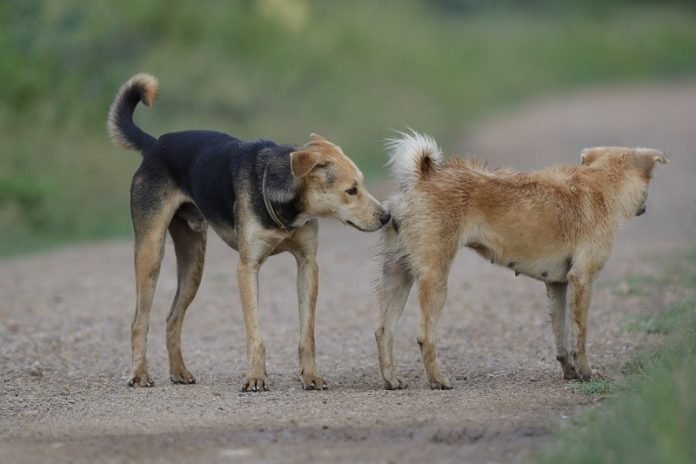Last Updated on March 4, 2024 by Asfa Rasheed
Dog matting is a problem that forms when the hair knots together. The mats can be difficult and painful for the dog to remove. In extreme cases, mats can pull on the skin and cause sores.
But why does this happen, and what can you do to avoid it?
Table of Contents
Causes of Dog Matting
Different breeds can have unique fur coats, but dogs usually have two types of coats. A primary coat is the one we see and feel, and it’s made up of (generally) straight layers of fibers. A secondary coat lies underneath. Called a down or undercoat, it is usually softer than the overcoat and comes out in tufts when stroked with your fingers.
The more common type of matting occurs in the outer coat of a dog with a thick undercoat. The knots often start where the secondary coat is thinnest, on the lower rear haunches and groin area.
Matting can have many causes:
- The dog may have a genetic predisposition to developing mats, especially if their parents had them.
- Clumping, oily sebaceous secretions (sebum) can clog hair follicles and cause matting. You should suspect sebaceous cysts if the coat feels greasy or looks waxy.
- If your dog swims a lot or gets wet often, the mats will worsen because the water will add weight to the hair, making it more likely to tangle and knot.
- Dogs kept in kennels or cages are also prone to developing mats as they cannot groom themselves properly.
- Poor grooming habits can also lead to a matted coat. For example, if your dog spends a lot of time lying on its side with the underside of its body against something – such as a fence or wall – matting may develop along the line of contact.
- A neglected hair coat can also cause matting as dirt and debris to make knots more challenging to brush out. These mats can cause discomfort when they pull on the skin.
How Can You Tell If Your Dog Is Matting?
Some dogs maintain good grooming habits throughout their lives, while others do not. It is not unusual for some dogs’ coats to become matted due to neglect.
If your dog has frequent matting problems, you should look closely at the coat and skin for redness or sores that may indicate a problem area.
In most cases, mats pull on the skin when you brush them out. If your dog is having problems with mats, you will see the following signs:
- The coat feels greasy or waxy.
- The hair is falling out in patches.
- The skin is red and irritated.
- There are bald spots on the body.
How Can You Prevent Dog Matting?
Maintaining a healthy coat and preventing matting is more manageable than fixing a badly matted fur. The following tips will help you keep your dog’s coat healthy and free from mats:
1. Brush Your Dog’s Hair Regularly
Brush your dog’s hair at least once a day, preferably twice. This will help remove any dirt or debris that may cause mats to form. You can use different brushes, depending on the type of hair your pet has:
- A slicker brush is suitable for thick coats.
- A bristle brush has bristles thinner than a slicker brush, so they are better suited for dogs with thin or medium-thick coats.
- A metal brush is suitable for thick, coarse coats.
Start by brushing the inside of the hind legs, then along either side of the body to the neck. Then you can do a quick once-over with your slicker brush before moving on to your dog’s head and front limbs.
2. Trim the Hair Around the Ears and Feet
Clipping the hair on a dog’s ears and feet can prevent matting. If you have a breed with long hair on its face, such as a Cocker Spaniel or Lhasa Apso, consider cutting the hair short around the eyes, nose, and mouth area to make it easier to see your dog’s skin.
Keep in mind, though, that you cannot use any pair of scissors. You need to invest in dog shears and then complement them with clippers.
3. Bathe Your Dog Regularly
Bathing your dog at least once a month will help keep the coat clean and free from oils and sebum that can cause mats to form. Be sure to use a good-quality shampoo specifically for dogs and avoid human shampoo. It can be too harsh for a dog’s delicate skin.
4. Inspect Your Dog’s Coat and Skin for Mats Regularly
If you are seeing any of the signs of matting, such as greasy hair, bald patches, or red, irritated skin, take the time to carefully inspect the coat and remove any mats that you find. This may require using a metal comb, such as a flea comb, to get through the knots.
Mats can be a nuisance for both dogs and their owners. They are often difficult to remove and can cause skin irritation if left untreated.
Preventing mats is much easier than trying to get rid of them after they have formed. By following the tips listed in this article, you can help keep your dog’s coat healthy and mat-free.
Read More: The Crucial Content Marketing Metrics You Need to Track at All Times.
















